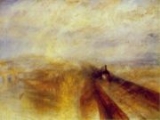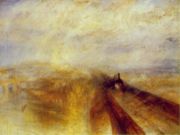
Maidenhead Railway Bridge
Encyclopedia

Bridge
A bridge is a structure built to span physical obstacles such as a body of water, valley, or road, for the purpose of providing passage over the obstacle...
carrying the main line of the Great Western Railway
Great Western Railway
The Great Western Railway was a British railway company that linked London with the south-west and west of England and most of Wales. It was founded in 1833, received its enabling Act of Parliament in 1835 and ran its first trains in 1838...
over the River Thames
River Thames
The River Thames flows through southern England. It is the longest river entirely in England and the second longest in the United Kingdom. While it is best known because its lower reaches flow through central London, the river flows alongside several other towns and cities, including Oxford,...
between Maidenhead
Maidenhead
Maidenhead is a town and unparished area within the Royal Borough of Windsor and Maidenhead, in Berkshire, England. It lies on the River Thames and is situated west of Charing Cross in London.-History:...
, Berkshire
Berkshire
Berkshire is a historic county in the South of England. It is also often referred to as the Royal County of Berkshire because of the presence of the royal residence of Windsor Castle in the county; this usage, which dates to the 19th century at least, was recognised by the Queen in 1957, and...
and Taplow
Taplow
Taplow is a village and civil parish within South Bucks district in Buckinghamshire, England. It sits on the east bank of the River Thames facing Maidenhead on the opposite bank. Taplow railway station is situated near the A4 south of the village....
, Buckinghamshire
Buckinghamshire
Buckinghamshire is a ceremonial and non-metropolitan home county in South East England. The county town is Aylesbury, the largest town in the ceremonial county is Milton Keynes and largest town in the non-metropolitan county is High Wycombe....
, England
England
England is a country that is part of the United Kingdom. It shares land borders with Scotland to the north and Wales to the west; the Irish Sea is to the north west, the Celtic Sea to the south west, with the North Sea to the east and the English Channel to the south separating it from continental...
. It crosses the Thames on the reach between Bray Lock
Bray Lock
Bray Lock is a lock and weir on the River Thames in England near Bray and Dorney and is just above the M4 Bridge across the Thames. The lock is on the Buckinghamshire side of the river on the opposite bank from Bray itself and Maidenhead which are in Berkshire...
and Boulter's Lock
Boulter's Lock
Boulter's Lock is a lock and weir on the River Thames in England on the eastern side of Maidenhead, Berkshire. A lock was first built here by the Thames Navigation Commission in 1772. The lock is on the western side of the river between the main Maidenhead to Cookham road and Ray Mill Island...
at the downstream end of Guards Club Island
Guards Club Island
Guards Club Island, also known as Bucks Ait, is an island in the River Thames at Maidenhead Railway Bridge, Berkshire. The island is connected to Guards Club Park by a low cast-iron and wood footbridge which blocks the channel from navigation...
.
History
The bridge was designed by the Great Western's engineer, Isambard Kingdom BrunelIsambard Kingdom Brunel
Isambard Kingdom Brunel, FRS , was a British civil engineer who built bridges and dockyards including the construction of the first major British railway, the Great Western Railway; a series of steamships, including the first propeller-driven transatlantic steamship; and numerous important bridges...
, and it was completed in 1838, but not brought into use until 1 July 1839. The railway is carried across the river on two brick
Brick
A brick is a block of ceramic material used in masonry construction, usually laid using various kinds of mortar. It has been regarded as one of the longest lasting and strongest building materials used throughout history.-History:...
arch
Arch
An arch is a structure that spans a space and supports a load. Arches appeared as early as the 2nd millennium BC in Mesopotamian brick architecture and their systematic use started with the Ancient Romans who were the first to apply the technique to a wide range of structures.-Technical aspects:The...
es, which at the time of building were the widest and flattest in the world. Each span is 128 feet (39 m), with a rise of only 24 feet (7 m). The flatness of the arches was necessary to avoid putting a "hump" in the bridge, which would have gone against Brunel's obsession with flat, gentle gradients (1 in 1,320 on this stretch). The Thames towpath
Towpath
A towpath is a road or trail on the bank of a river, canal, or other inland waterway. The purpose of a towpath is to allow a land vehicle, beasts of burden, or a team of human pullers to tow a boat, often a barge...
passes under the right-hand arch (facing upstream), which is also known as the Sounding Arch, because of its spectacular echo
Echo (phenomenon)
In audio signal processing and acoustics, an echo is a reflection of sound, arriving at the listener some time after the direct sound. Typical examples are the echo produced by the bottom of a well, by a building, or by the walls of an enclosed room and an empty room. A true echo is a single...
.
It has been claimed that the board of the Great Western Railway did not believe that the arches would stay up under the weight of the trains and ordered Brunel to leave the wooden formwork used to construct the arches in place. However, Brunel simply lowered the formwork slightly so that it had no structural effect, but appeared to be in place. Later, when the formwork was washed away in floods, but the bridge remained, the strength of the arches was accepted.
As built, Maidenhead Railway Bridge carried two lines of Brunel's broad gauge
Broad gauge
Broad-gauge railways use a track gauge greater than the standard gauge of .- List :For list see: List of broad gauges, by gauge and country- History :...
track. Subsequently the bridge has been widened, and now carries the four lines of standard gauge
Standard gauge
The standard gauge is a widely-used track gauge . Approximately 60% of the world's existing railway lines are built to this gauge...
track that make up the Great Western Main Line
Great Western Main Line
The Great Western Main Line is a main line railway in Great Britain that runs westwards from London Paddington station to the west of England and South Wales. The core Great Western Main Line runs from London Paddington to Temple Meads railway station in Bristol. A major branch of the Great...
out of London Paddington Station
Paddington station
Paddington railway station, also known as London Paddington, is a central London railway terminus and London Underground complex.The site is a historic one, having served as the London terminus of the Great Western Railway and its successors since 1838. Much of the current mainline station dates...
.
Maidenhead Railway Bridge features in Rain, Steam and Speed - The Great Western Railway, painted by Turner
J. M. W. Turner
Joseph Mallord William Turner RA was an English Romantic landscape painter, watercolourist and printmaker. Turner was considered a controversial figure in his day, but is now regarded as the artist who elevated landscape painting to an eminence rivalling history painting...
in 1844 and now in the National Gallery
National Gallery, London
The National Gallery is an art museum on Trafalgar Square, London, United Kingdom. Founded in 1824, it houses a collection of over 2,300 paintings dating from the mid-13th century to 1900. The gallery is an exempt charity, and a non-departmental public body of the Department for Culture, Media...
, London
London
London is the capital city of :England and the :United Kingdom, the largest metropolitan area in the United Kingdom, and the largest urban zone in the European Union by most measures. Located on the River Thames, London has been a major settlement for two millennia, its history going back to its...
Crossrail Modifications
The forthcoming CrossrailCrossrail
Crossrail is a project to build a major new railway link under central London. The name refers to the first of two routes which are the responsibility of Crossrail Ltd. It is based on an entirely new east-west tunnel with a central section from to Liverpool Street station...
development shall see the long-delayed overhead electrification of the Great Western line between Paddington and Maidenhead or Reading. This construction work had been set to require a temporary construction depot to be created immediately next to the bridge in Guards Club Park on the Berkshire side of the bridge, but this decision has subsequently been reversed, though the Bridge itself will obviously still undergo some changes in order to accommodate the Overhead line equipment
Overhead lines
Overhead lines or overhead wires are used to transmit electrical energy to trams, trolleybuses or trains at a distance from the energy supply point...
. The latest Crossrail Environmental Statement states:
"The OHLE (Overhead Line Equipment) requires that supporting posts be founded on the bridge structure. These will be positioned so as not to disrupt the symmetry of the bridge. Three sets of masts will be fixed at the bridge supports and a further two sets will be fixed at the far ends of the bridge. The masts will be fixed such that they may be removed in the future without damaging the bridge as it stands today."
The report also states:
It is proposed that the OHLE over Maidenhead railway bridge will use masts with wires suspended from cantilevers, since these will be visually lighter structures than the gantries to be used along other parts of the route. The masts will however, have a significant adverse landscape impact: they will affect important views along the river and the character of the river corridor; they will affect the setting of the Riverside Conservation Area; and they will affect the setting of the listed railway bridge and the setting of the adjacent Grade I listed road bridge.
The possibility of using third rail
Third rail
A third rail is a method of providing electric power to a railway train, through a semi-continuous rigid conductor placed alongside or between the rails of a railway track. It is used typically in a mass transit or rapid transit system, which has alignments in its own corridors, fully or almost...
electrification on the bridge was considered but rejected.
External links
- Newcomen Society information. (NB This site labels the rail bridge as "Maidenhead Bridge" and Maidenhead BridgeMaidenhead BridgeMaidenhead Bridge is a Grade I listed bridge carrying the A4 road over the River Thames between Maidenhead, Berkshire and Taplow, Buckinghamshire, England. It crosses the Thames on the reach above Bray Lock, about half a mile below Boulter's Lock.-History:...
as "Maidenhead Road Bridge")

